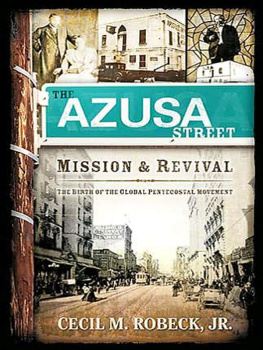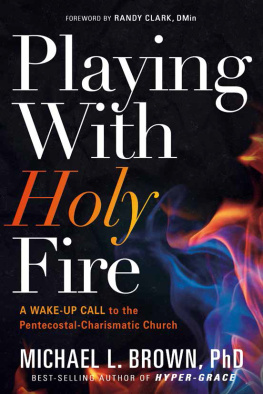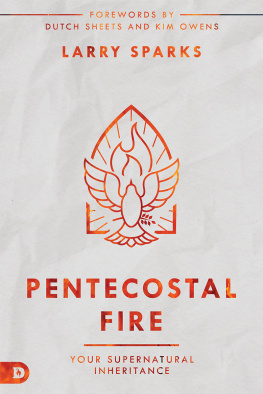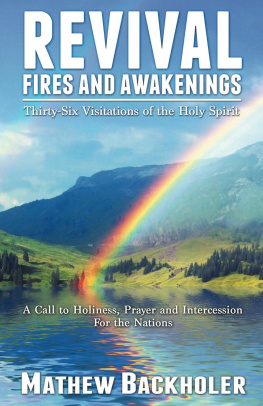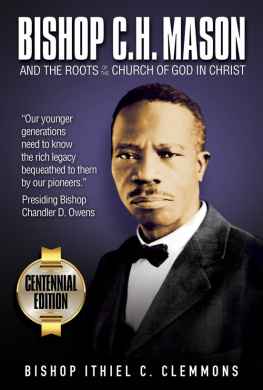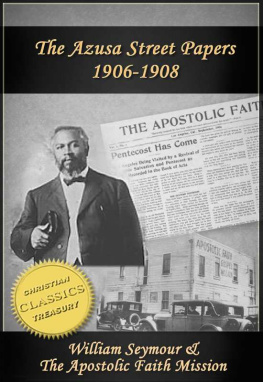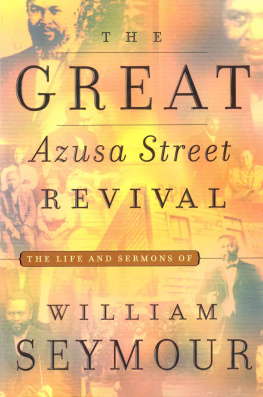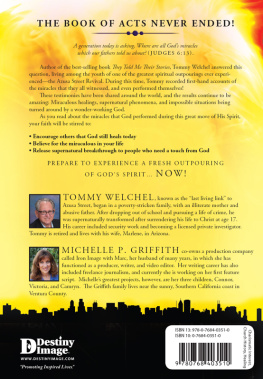THE AZUSA STREET MISSION
AND REVIVAL

The Birth of the
Global Pentecostal Movement
CECIL M. ROBECK JR.

The Azusa Street Mission and Revival: The Birth of the Global Pentecostal Movement
Copyright 2006 by Cecil M. Robeck, Jr.
Published in Nashville, Tennessee, by Thomas Nelson, Inc.
All rights reserved. No portion of this book may be reproduced, stored in a retrieval system, or transmitted in any form by any meanselectronic, mechanical, recording, or any otherexcept for brief quotations in critical reviews or articles, without the prior permission of the publisher.
Scripture references are from the Holy Bible, King James Version.
Portions of the Afterword were originally published as Cecil M. Robeck, Jr, Reflections on the Role of Revival. The Church of God Evangel 91:11 (November 2001), 2830. The author wishes to thank The Church of God Evangel for permission to reprint them here.
Illustrations on the following pages are from the personal collection of Cecil M. Robeck, Jr., 28, 32, 37, 45, 47, 51, 54, 55, 58, 61, 64, 79, 90, 97, 113, 120, 122, 134, 170, 172, 191, 193, 194, 199, 201, 202, 211, 205, 228, 251, 257, 263, 265, 308. Illustrations reproduced by the kind permission of the following institutions and persons: Apostolic Faith Mission, Portland, Oregon, 215; Apostolic Faith Mission of South Africa, 274; Esther Brinkley, 273; Flower Pentecostal Heritage Center, 36, 42, 44, 68, 71, 100, 110, 130, 192, 203, 206, 220, 226, 232, 233; International Pentecostal Holiness Church Archives and Research Center, 217; Maxine Van Dyke, 264; and The Miriam Matthews Collection, 70.
Library of Congress Cataloging-in-Publication Data available upon request
Robeck, Cecil M.
The Azusa Street Mission and revival: the birth of the global
Pentecostal movement / Cecil M. Robeck, Jr.
p. cm.
ISBN 1-4185-0624-9
1. Pentecostalism. 2. Pentecostal churchesMissions. 3. Azusa
Street Mission (Los Angeles, Calif.) I. Title.
BR1644.R59 2006 277.3'082dc22 2005033675
Book design and composition by Mark McGarry, Texas Type & Book WorksSet in Monotype Dante
Printed in the United States of America
1 2 3 4 5 6 7 10 09 08 07 06
I dedicate this book to
My Parents
Cecil M. Robeck and Berdetta M. [Manley] Robeck
and to the generation of
Pastors, Missionaries, Evangelists, Church Planters and Leaders
that preceded them in communicating the
Apostolic Faith around the world.
Among them were
Axel Edwin Robeck, Laura Elizabeth [Arneson] Robeck,
and Emmy [Pierson] Robeck
Eddie Olaf Robeck and Esther [Bogue] Robeck
and
Andrew Edward Robeck and Myrtle W. [Peterson] Robeck.
CONTENTS
I dont remember where and when this project first began. I suppose it was in the testimonies of the old-timers that I heard as a boy. Their stories kindled a fire in me that I have never been able to quench. When I moved to Pasadena, California in 1970, I was fortunate to get to know four Azusa Street participants quite well: Clyde Rogers, Fred Griesinger, Harold Fisher, and John Bartleman. I was also able to interview several others.
Some of the impetus for this project belongs with the late Dr. Art Glass. He hoped that I would publish the story of Azusa Street in a popular format that would instill a sense of pride in the young people of the Church of God in Christ. I wish he were here to tell me whether this is the book he had in mind. For help and insight into parts of the African American story, I am deeply indebted to Drs. Anthea Butler, Leslie Callahan, David Daniels, Sherry Sherrod Dupree, Leonard Lovett, A. G. Miller, the late James Tinney, Mr. Alexander C. Stewart, and the late Bishop Ithiel Clemmons.
I owe a debt of gratitude to my friend Dr. George O. Wood, General Secretary of the Assemblies of God, who a decade ago invited me to take him, his wife, and a few of their friends on a tour of the Los Angeles sites related to the Azusa Street Mission and revival. I want to thank George and the seventy-five hundred other people who have since taken this day-long pilgrimage with me. Your challenges, questions, and suggestions have made this project all the more worthwhile.
And then there are my students. I wish to extend a deep and heartfelt Thanks to each of the many students at Fuller who have taken my course on the history of the Pentecostal and charismatic movements. Your willingness to undertake a number of creative research assignments related to this study places me very much in your debt!
Along the way, I have been encouraged repeatedly to continue my research as part of Fuller Theological Seminarys generous sabbatical program. Its president, Dr. Richard J. Mouw, has provided me with occasional, good-natured goads: Robeck, when are you going to write something ordinary people will read? I sure hope this works! My dear friend and former colleague Dr. Russell P. Spit-tler has been a consistent source of encouragement and a primary sounding board on many aspects of this study, especially on issues related to Pentecostal/charismatic spirituality.
The John Randolph Haynes and Dora Haynes Foundation gave me a substantial grant that first enabled me to travel to several key cities and undertake a year of mind-numbing detail-chasing that lies behind this volume and several others that I expect will follow. The Huntington Library granted me a quiet space during one of my year-long sabbaticals. The Assemblies of God has given a great gift to me in the Flower Pentecostal Heritage Center and its incredibly helpful staffespecially Mr. Wayne Warner, Mrs. Joyce Lee, and Mr. Glenn Gohr. The Morgan City Historical Society staff helped me understand the southern Louisiana coastal parishes. Mr. Darrol Pierson of the Indiana State Library pointed me in several fruitful directions. Wilma L. Gibbs, director of the Indiana Historical Society, was always ready to respond to my questions. Ms. Carolyn Garner-Reagan, a former research librarian at the Pasadena Public Library, guided me to valuable resources on the history of Southern California and helped me to find the passenger list of the SS Campania.
A word of thanks also goes to Mrs. Karen Barrett and to the Rev. Dwight Baltzell, former General Superintendent of the Apostolic Faith Mission (Portland, OR), for access to the archive there; to Dr. Harold D. Hunter, director of the International Pentecostal Holiness Archive and Research Center, and his assistant Ms Erica Rutland for their repeated help; and to Mr. Peter DeWitt and Dr. Franois Mller for making it possible for me to explore the archival holdings of the Apostolic Faith Mission in South Africa.
Many are the friends and associates who have contributed to this study as well. Drs. Allan Anderson, Edith Blumhofer, David Bundy, Augustus Cerillo, Joseph Coletti, Donald Dayton, Gastn Espinosa, William Faupel, Harold Helms, Philip Hilliard, Walter Hollen-weger, Gary McGee, Wonsuk Ma, Robert Meye, Douglas Nelson, Jean Daniel Plss, Jim Phillips, and Grant Wacker have all been wonderful dialogue partners providing helpful insights and gentle provocations through the years. Mr. G. Wayne Pendleton provided information and photographs on the Pendleton family. Maxine Van Dyke gave me materials on Antoinette Moomau. The late Mrs. Grace (Smale) Westberg shared information and materials on Joseph Smale. Esther Brinkley furnished materials on Daniel Awrey. And Robert Fisher supplied me with information and photographs on his grandfather, Elmer K. Fisher. Mr. Jan-Endy Johanneson took me to used book stores in Stockholm and gave me complete access to a number of early Swedish sources. Mr. Helge Christenson turned my crude attempts at translation from these documents into understandable English. And Mr. Glen Blossom provided me with copies of the
Next page
